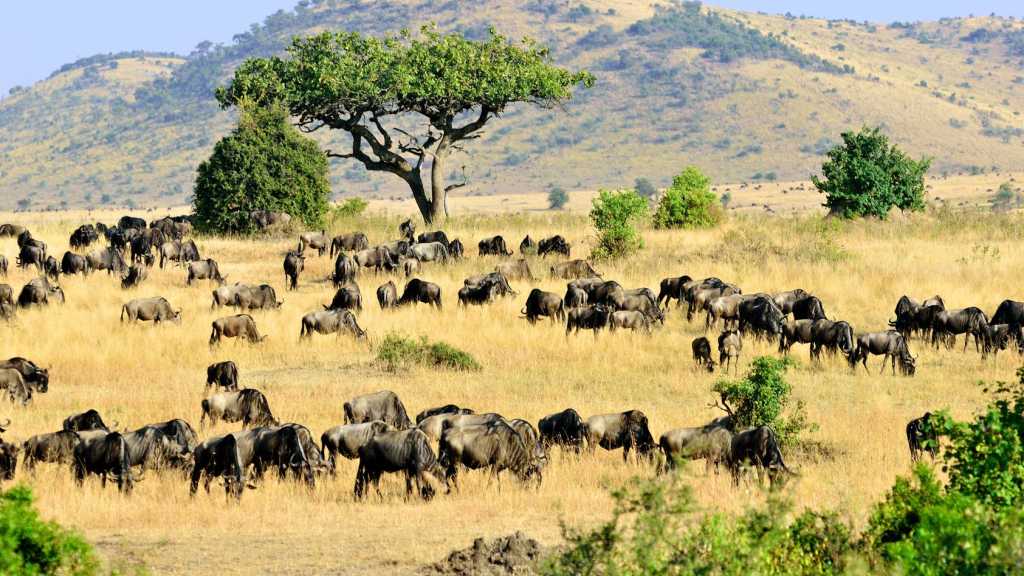World Heritage-listed, the great Masai Mara Reserve is crossed by the Mara River which is home to countless animals.
Every year, in July and August, thousands of wildebeest and zebras arrive from Tanzania after a long transhumance. Few places on earth can boast such rich wildlife, and savannah populated with Mara's wildebeest is undoubtedly the main attraction of the region.
- Masai Mara Park is part of one of the largest preserved ecosystems on the planet, covering 25,000 km2 including the Ngorongoro Conservation Area and Serengeti in Tanzania. Listed as World Heritage of Humanity, this park is the scene of the largest animal migration still existing: more than 1 million wildebeest and several hundred thousand zebras and antelopes, and a large number of predators. In the dry season, the bulk of the herd gathers in the Masai Mara, which enjoys regular thunderstorms. It's time to admire the impressive spectacle of the Mara River crossings!
- Tsavo Park is one of the few in Kenya where it is possible to go on a walking safari. Under escort of the guards, go exploring on foot every corner of the park. You live a truly unique experience.
- Enjoy the months of June to October to observe the wildlife in the parks of southern Kenya, far from the Masai Mara!
Going to Kenya is to travel 8 million years back, at a time when nature was sovereign and where the great upheavals of humanity were operating.
Undisputed master of photo safaris, Kenya is a country offering at every moment a testimony of our origins. The key to all of this is the Rift Valley, a large natural fault that crosses the country and shapes the landscape little by little. First, a string of large lakes on which the largest population of birds on the continent is concentrated; then comes the savannah concealed in the bottom of the fault and sheltering a multitude of wild animals and game. Whether it is tall grass dried by the sun's rays, acacia trees, palm doums or baobabs, the wonder is there. It is against the backdrop of the old volcanic mountains, Mount Kenya, 5,199 meters high, is proud to compete with his big brother Tanzanian. Finally arrive kilometers of white sand bordering the Indian Ocean, In this great diversity live together more than 40 ethnic groups with ancestral traditions of origin often Bantu. It is certain, Africa is there.
When to go?
Equatorial, the climate is however subject to important general variations. Kenya enjoys a sunny climate most of the year. The rainy season is in April and May where heavy short-term rainfall may surprise.
Thus, the best time to visit Kenya is summer, from June to September, during which you will enjoy the dry season and reasonable temperatures.
Formalities
French nationals must hold a visa ("tourism" or "business" depending on the purpose of the visit) to enter Kenya. The passport must have a validity of at least six months on the date of entry into the territory.
Since September 1st 2015, an electronic visa, issued online and within one week, should be obtained from the site https://account.ecitizen.go.ke/visitor-registrationprior to arrival in Kenya.
Health
Antimalarial treatment and yellow fever vaccination is recommended (contact your doctor)
Currency
The national currency is the Kenyan shilling (KES).
International credit cards can be used in major cities and tourist areas (hotels, lodges, reserves, etc.). It is advisable to bring cash (US dollars or euros). Travel checks are to be avoided. There are ATMs (Visa, Eurocard, Mastercard) in Nairobi and Mombasa. For foreign exchange transactions, attention should be paid to the proposed rate. US dollars are better accepted than euros.
Attention: Old dollars aren’t accepted: in general, those dating from before 2006, although sometimes those after 2000 or 2003 are accepted - all depends on the interlocutor.
